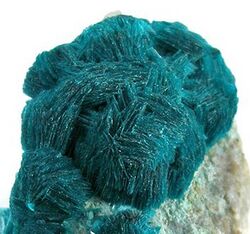Chemistry:Devilline
| Devilline | |
|---|---|
 Devilline | |
| General | |
| Category | Sulfate minerals |
| Formula (repeating unit) | CaCu4(SO4)2(OH)6·3(H2O) |
| Strunz classification | 7.DD.30 |
| Crystal system | Monoclinic |
| Crystal class | Prismatic (2/m) (same H-M symbol) |
| Space group | P21/c |
| Unit cell | a = 20.870, b = 6.135 c = 22.91 [Å], β = 102.73° V = 2,861.23 Å3 |
| Identification | |
| Color | Green, blueish green; green in transmitted light |
| Crystal habit | Prismatic, lamellar, platy pseudohexagonal crystals |
| Twinning | On {010} |
| Cleavage | Perfect (001) distinct (110) and (101) |
| Tenacity | Brittle |
| Mohs scale hardness | 2.5 |
| |re|er}} | Vitreous, pearly |
| Streak | Light green |
| Density | Measured: 3.13 g/cm3 Calculated: 3.084 g/cm3 |
| Optical properties | biaxial negative |
| Refractive index | nα=1.585, nβ=1.649, nγ=1.660 |
| Birefringence | δ=0.075 |
| Pleochroism | Visible |
| 2V angle | 42° |
| Solubility | Insoluble in water and concentrated H2SO4. Completely soluble in HNO3. |
| References | [1][2] |
Devilline is a sulfate mineral with the chemical formula CaCu4(SO4)2(OH)6·3H2O. The name originates from the French chemist's name, Henri Etienne Sainte-Claire Deville (1818–1881).
Devilline crystallizes in the monoclinic system.[4] Crystallographically, it contains three vectors of unequal lengths and two pairs of vectors are perpendicular while the other pair makes an angle other than 90°. Devilline is prismatic and belongs to the crystal class 2/m. This mineral belongs to the space group P 21/c. Devilline is an anisotropic mineral, meaning that the mineral has different properties in different directions. Optically, this mineral is biaxial negative, meaning that it contains two optic axes. Devilline has a moderate mineral relief. Mineral relief refers to the way a mineral appears to stand out when viewed under polarized light and it is dependent on the mineral's index of refraction.
Devilline is a rare and unusual secondary mineral found in the oxidized portions of copper sulfide ore deposits.[5] Because Devilline occurs in such oxidation zones, this mineral often is of post-mining origin. Devilline is found in mines all around the world.
Devilline group
Devilline group minerals are monoclinic sulfates.[6]
| Mineral | Chemical formulae | Crystal system |
|---|---|---|
| Campigliaite | Cu4Mn2+(SO4)2(OH)6·4H2O | Monoclinic |
| Devilline | CaCu4(SO4)2(OH)6·3H2O | Monoclinic |
| Kobyashevite | Cu5(SO4)2(OH)6·4H2O | Triclinic |
| Ktenasite | Zn(Cu,Zn)4(SO4)2(OH)6·6H2O | Monoclinic |
| Lautenthalite | PbCu4(SO4)2(OH)6·3H2O | Monoclinic |
| Serpierite | Ca(Cu,Zn)4(SO4)2(OH)6·3H2O | Monoclinic |
References
- ↑ "Devilline on Mindat". http://www.mindat.org/min-1270.html.
- ↑ "Devilline Mineral Data – Webmineral". http://webmineral.com/data/Devilline.shtml.
- ↑ Warr, L.N. (2021). "IMA–CNMNC approved mineral symbols". Mineralogical Magazine 85 (3): 291–320. doi:10.1180/mgm.2021.43. Bibcode: 2021MinM...85..291W. https://www.cambridge.org/core/journals/mineralogical-magazine/article/imacnmnc-approved-mineral-symbols/62311F45ED37831D78603C6E6B25EE0A.
- ↑ Back, M., and Mandrine, J. (2008) Fleischer's Glossary of Mineral Species 2008. 58 p. Mineralogical Record, Tuscan, Arizona
- ↑ Anthony, John W.; Bideaux, Richard A.; Bladh, Kenneth W.; Nichols, Monte C. (2005). "Devilline". Mineral Data Publishing. http://www.handbookofmineralogy.org/pdfs/devilline.pdf.
- ↑ Back, Malcolm E. (2014). Fleischer's Glossary of Mineral Species (11 ed.). Tucson AZ: Mineralogical Record Inc.. pp. 434.
 |

